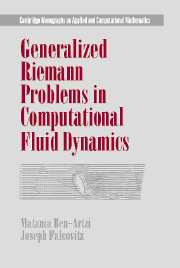Book contents
- Frontmatter
- Contents
- List of Figures
- Preface
- 1 Introduction
- I BASIC THEORY
- 2 Scalar Conservation Laws
- 3 The GRP Method for Scalar Conservation Laws
- 4 Systems of Conservation Laws
- 5 The Generalized Riemann Problem (GRP) for Compressible Fluid Dynamics
- 6 Analytical and Numerical Treatment of Fluid Dynamical Problems
- II NUMERICAL IMPLEMENTATION
- A Entropy Conditions for Scalar Conservation Laws
- B Convergence of the Godunov Scheme
- C Riemann Solver for a γ-Law Gas
- D The MUSCL Scheme
- Bibliography
- Glossary
- Index
3 - The GRP Method for Scalar Conservation Laws
Published online by Cambridge University Press: 20 August 2009
- Frontmatter
- Contents
- List of Figures
- Preface
- 1 Introduction
- I BASIC THEORY
- 2 Scalar Conservation Laws
- 3 The GRP Method for Scalar Conservation Laws
- 4 Systems of Conservation Laws
- 5 The Generalized Riemann Problem (GRP) for Compressible Fluid Dynamics
- 6 Analytical and Numerical Treatment of Fluid Dynamical Problems
- II NUMERICAL IMPLEMENTATION
- A Entropy Conditions for Scalar Conservation Laws
- B Convergence of the Godunov Scheme
- C Riemann Solver for a γ-Law Gas
- D The MUSCL Scheme
- Bibliography
- Glossary
- Index
Summary
This chapter introduces the GRP method in the context of the scalar conservation law ut + f(u)x = 0. We start in Section 3.1 with the classical first-order (conservative) “Godunov Scheme,” which leads naturally to its second-order GRP extension. Section 3.2 contains a number of numerical (one-dimensional) examples, for linear and nonlinear equations, illustrating the improved resolution obtained by the GRP method. In Section 3.3 we extend the GRP methodology to the two-dimensional scalar conservation law ut + f(u)x + g(u)y = 0. Analytical and numerical results are compared for simple as well as complex wave interactions.
From Godunov to the GRP Method
In this section we discuss the GRP method, aimed at a high-resolution numerical approximation of the solution to a conservation law of the form (2.1). We always assume that f(u) is strictly convex:f″(u) ≥ μ > 0. It is shown that this method is a natural analytic extension to the Godunov (upwind) scheme. This latter scheme has been extensively studied in Section 2.2, in the context of the linear convection equation. We start here by studying this scheme in the nonlinear case.
As in Section 2.2, we take a uniform spatial grid xj = jΔx, − ∞ < j < ∞, and uniformly spaced time levels tn+1 = tn+k, t0 = 0.
- Type
- Chapter
- Information
- Publisher: Cambridge University PressPrint publication year: 2003

